Do not trust the "Your mailbox is full" scam emails
Phishing/ScamAlso Known As: Your Mailbox Is Full spam
Get free scan and check if your device is infected.
Remove it nowTo use full-featured product, you have to purchase a license for Combo Cleaner. Seven days free trial available. Combo Cleaner is owned and operated by RCS LT, the parent company of PCRisk.com.
What is the "Your mailbox is full" scam email?
"Your mailbox is full" is the name of a spam campaign, a large-scale operation during which deceptive/scam emails are sent by the thousand. The messages distributed through this campaign inform recipients that their email accounts require updates.
These spam messages aim to promote a phishing website, presented as an email account log-in page. Sites of this type operate by recording information entered into them.
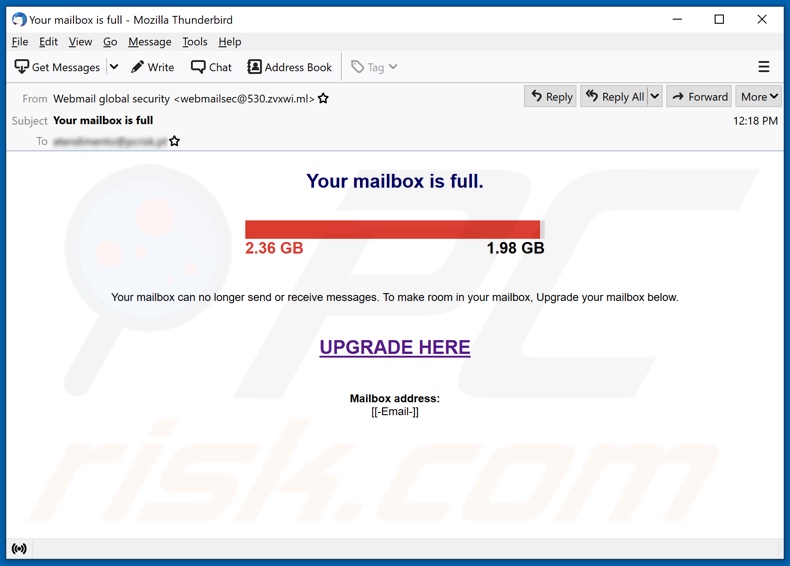
"Your mailbox is full" email scam overview
There are two variants of the "Your mailbox is full" scam emails (the subject/titles "Your mailbox is full" and "ERROR ID: Mail-box storage full UPGRADE NOW!!!" may vary). Both versions state that recipients cannot receive or send emails due to the inbox having reached its storage capacity.
To restore their email accounts, recipients are informed that they must update them. By clicking "UPGRADE HERE" or "UPDATE STORAGE" (depending on the email version), recipients are redirected to the promoted phishing site. This website is disguised as the sign-in page to email accounts.
Log-in credentials (i.e., passwords) entered into this web page are disclosed to the scammers behind the "Your mailbox is full" spam campaign. Therefore, by trusting these deceptive messages, recipients can have their emails stolen and potentially experience other serious issues.
Email accounts are of particular interest to scammers/ cyber criminals, as they are typically connected to other platforms and services. Through hijacked emails, access may be gained to accounts tied to them.
For example, communication platforms (e.g., emails, social networking, social media, messengers, etc.) can be used to ask contact/friends for loans under the guise of the genuine owner. Platforms of this type can also be used to proliferate malware through sharing virulent files.
Scammers can use banking, digital wallet, online money transferring, e-commerce, and similar finance-related accounts to make fraudulent transactions and online purchases.
To summarize, trusting the "Your mailbox is full" scam emails can lead to severe privacy issues, system infections, financial losses, and identity theft.
If attempts to log-in through the phishing website have already been made, you are strongly advised to change the email account password and those of other potentially compromised accounts. Additionally, contact the official support of endangered accounts/platforms.
| Name | Your mailbox is full Email Scam |
| Threat Type | Phishing, Scam, Social Engineering, Fraud |
| Fake Claim | Emails claim recipients' mail account has reached its storage limit and requires updates. |
| Symptoms | Unauthorized online purchases, changed online account passwords, identity theft, illegal access of the computer. |
| Distribution methods | Deceptive emails, rogue online pop-up ads, search engine poisoning techniques, misspelled domains. |
| Damage | Loss of sensitive private information, monetary loss, identity theft. |
| Malware Removal (Windows) |
To eliminate possible malware infections, scan your computer with legitimate antivirus software. Our security researchers recommend using Combo Cleaner. Download Combo CleanerTo use full-featured product, you have to purchase a license for Combo Cleaner. 7 days free trial available. Combo Cleaner is owned and operated by RCS LT, the parent company of PCRisk.com. |
Phishing spam campaign examples
"Clustered e-mails pending", "UNITED NATIONS COMPENSATION (COVID19 ASSISTED PROGRAM)", "cPanel Email Scam", and "MOBI GRAND TELECOM Lottery" are some examples of other phishing spam campaigns.
The emails distributed through these operations are usually presented as "official", "urgent", "important", "priority", and so on. Spam mail is used not only for phishing but also for various different scams. The deceptive messages are also employed to spread trojans, ransomware, and other malware.
Due to the widespread nature of spam mail, exercise caution with incoming emails.
How do spam campaigns infect computers?
Typically, cyber criminals behind malspam campaigns send emails with a file attached to them or a download link to the malicious file. Their main goal is to trick recipients into opening/executing the rogue file, which then installs malicious software.
Some examples of files that cyber criminals send via email are Microsoft Office and PDF documents, executables (.exe), JavaScript, and archives (ZIP, RAR).
Note that malicious documents that are opened with Microsoft Office 2010 or newer versions install malicious software only if users enable macros commands (enable editing/content). These versions include "Protected View" mode, which does not allow opened malicious documents to install malware automatically. Older versions do not include this feature and install malicious software without asking permission.
How to avoid installation of malware
Do not trust irrelevant emails that have files attached (or contain website links) and are received from unknown, suspicious addresses. Software should not be downloaded or installed through third party downloaders, installers, unofficial pages or other similar sources/tools.
Use only official websites and direct links. Installed software should never be updated or activated with third party, unofficial tools, since they can install malware. Furthermore, it is illegal to use third party tools to activate licensed software.
The only legitimate way to update and activate software is to use tools and functions that are provided by the official developers. Regularly scan your computer with reputable antivirus or anti-spyware software and keep this software up to date.
If you have already opened malicious attachments, we recommend running a scan with Combo Cleaner Antivirus for Windows to automatically eliminate infiltrated malware.
Text presented in one of the "Your mailbox is full" scam email variants:
Subject: Your mailbox is full
Your mailbox is full.
2.36 GB 1.98 GB
Your mailbox can no longer send or receive messages. To make room in your mailbox, Upgrade your mailbox below.
UPGRADE HERE
Mailbox address:
[[-Email-]]
Screenshot of the "Your mailbox is full" scam email alternative variant:
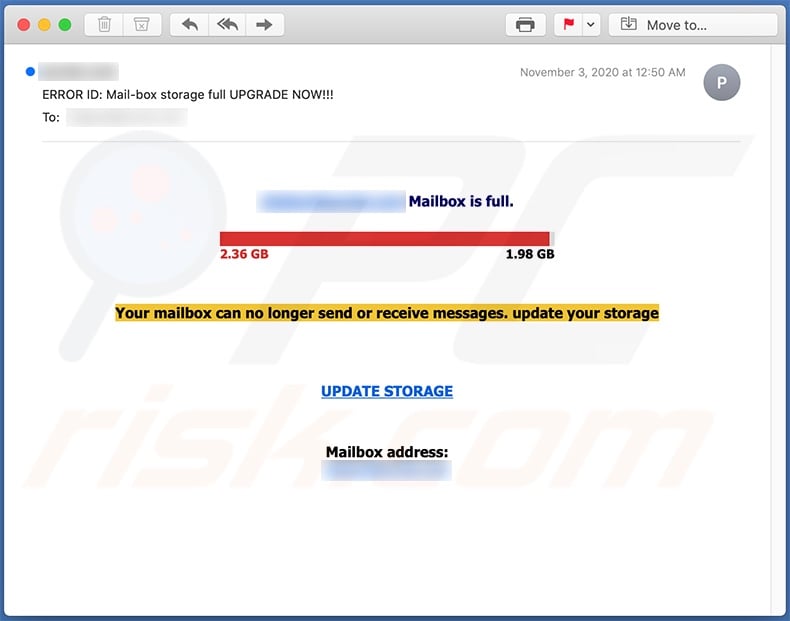
Text presented in this variant:
Subject: ERROR ID: Mail-box storage full UPGRADE NOW!!!
- Mailbox is full.
2.36 GB1.98 GB
Your mailbox can no longer send or receive messages. update your storage
UPDATE STORAGE
Mailbox address:
-
Screenshot of the phishing website promoted by "Your mailbox is full" spam campaign:
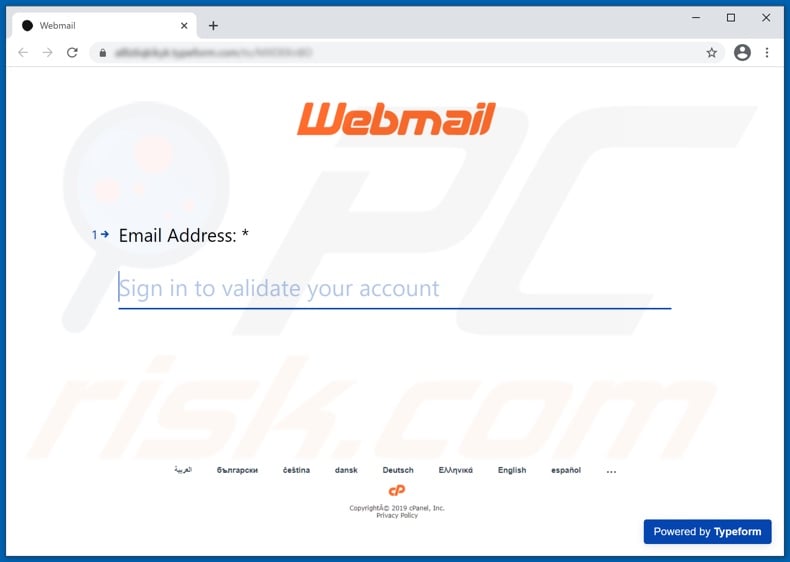
Another variant of email storage-themed spam email:
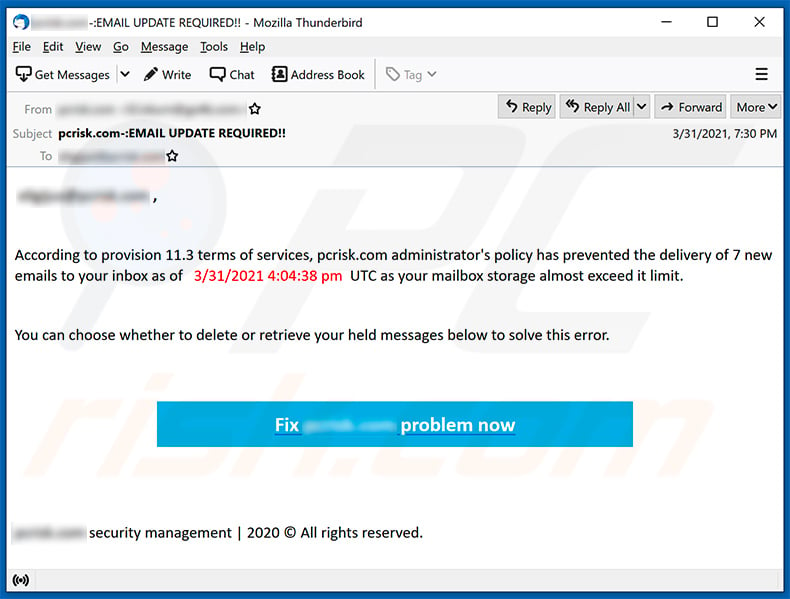
Text presented within:
Subject: - EMAIL UPDATE REQUIRED!!
******** ,
According to provision 11.3 terms of services, ******** administrator's policy has prevented the delivery of 7 new emails to your inbox as of 3/31/2021 4:04:38 pm UTC as your mailbox storage almost exceed it limit.
You can choose whether to delete or retrieve your held messages below to solve this error.Fix ******** problem now
******** security management | 2020 © All rights reserved.
Yet another variant of Your Mailbox Is Full scam email (the attached HTML file is used for phishing purposes - all input data is sent to a remote server):
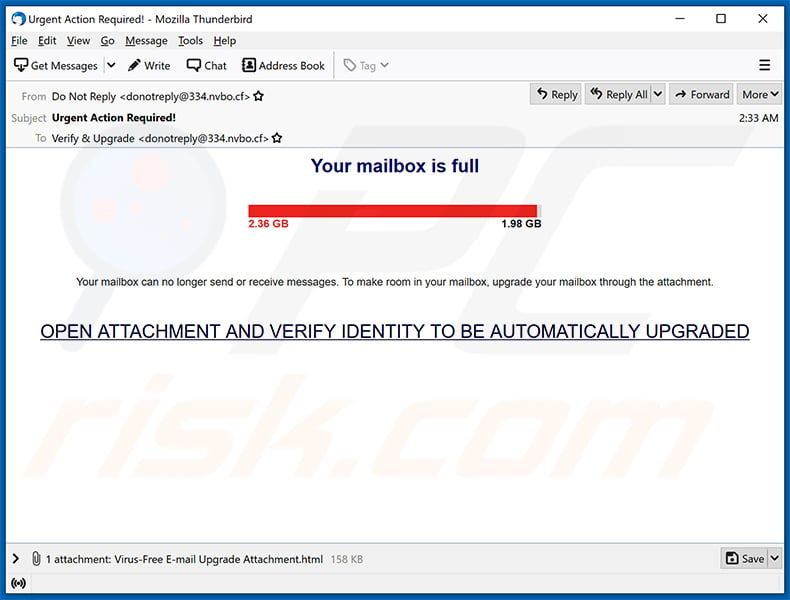
Text presented within:
Subject: Urgent Action Required!
Your mailbox is full
2.36 GB 1.98 GBYour mailbox can no longer send or receive messages. To make room in your mailbox, upgrade your mailbox through the attachment.
OPEN ATTACHMENT AND VERIFY IDENTITY TO BE AUTOMATICALLY UPGRADED
Screenshot of the attached HTML document ("Virus-Free E-mail Upgrade Attachment.html"):

Another example of "Your Mailbox Is Full" scam email:
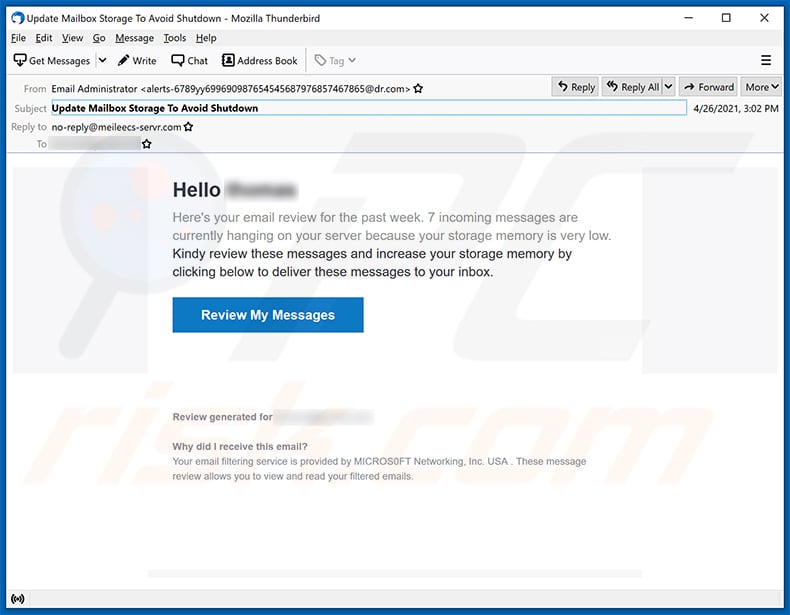
Text presented within:
Subject: Update Mailbox Storage To Avoid Shutdown
Hello ********
Here's your email review for the past week. 7 incoming messages are currently hanging on your server because your storage memory is very low.
Kindy review these messages and increase your storage memory by clicking below to deliver these messages to your inbox.
Review My MessagesReview generated for ********
Why did I receive this email?
Your email filtering service is provided by MICROS0FT Networking, Inc. USA . These message review allows you to view and read your filtered emails.
Screenshot of the phishing website promoted via this spam email:
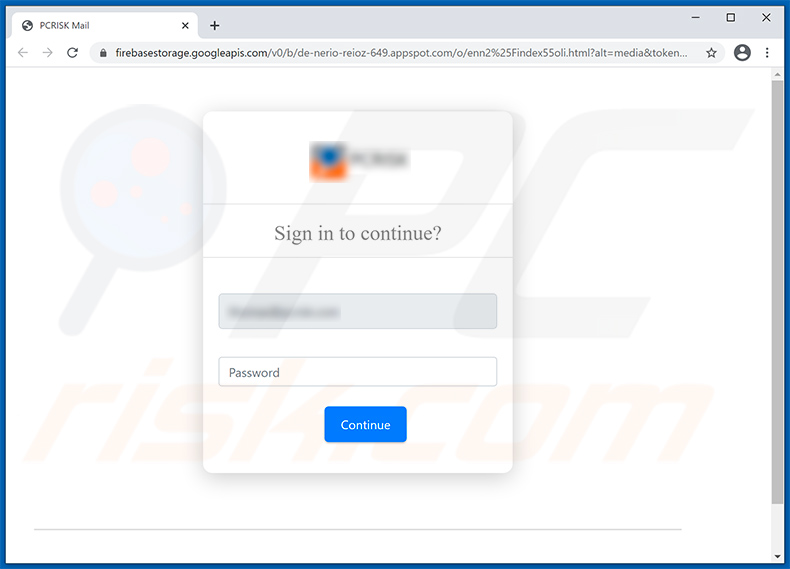
Yet another variant of mailbox capacity-themed spam email used to promote a phishing website:
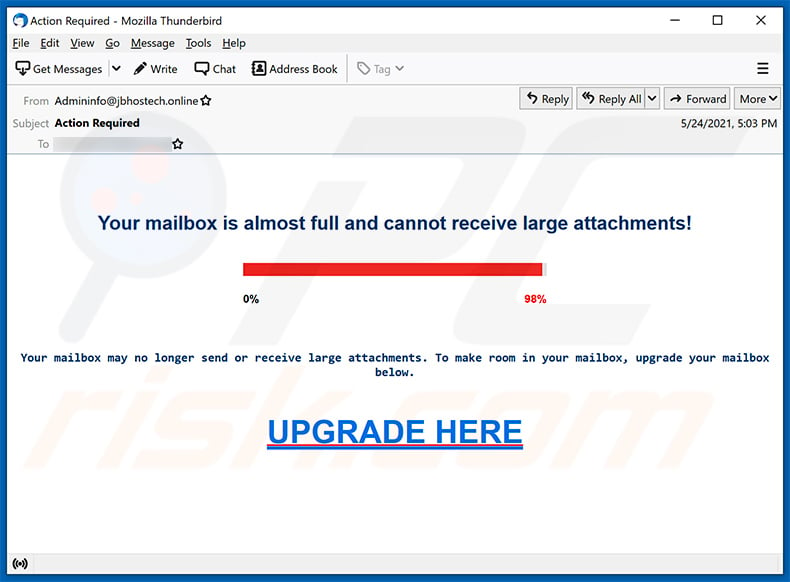
Text presented within:
Subject: Action Required
Your mailbox is almost full and cannot receive large attachments!
0% 98%
Your mailbox may no longer send or receive large attachments. To make room in your mailbox, upgrade your mailbox below.UPGRADE HERE
Screenshot of the promoted phishing website:
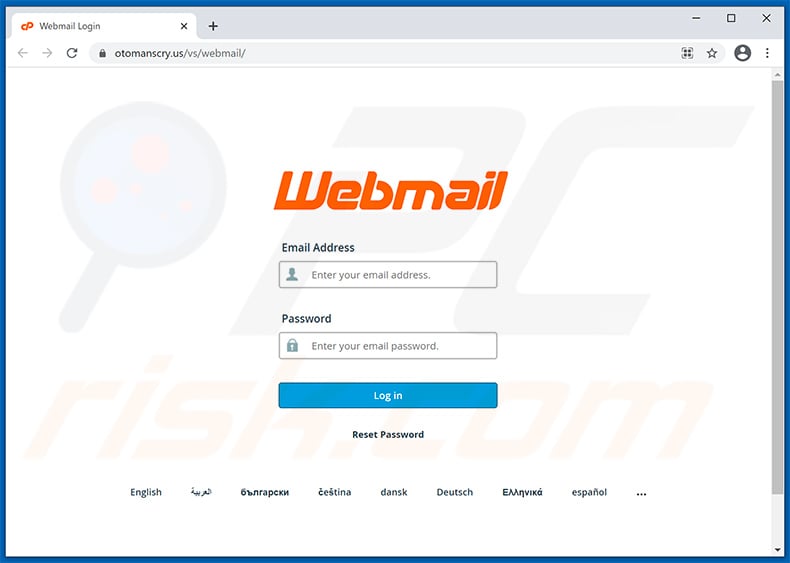
Yet another "Your Mailbox Is Full"-themed scam email promoting a phishing site:
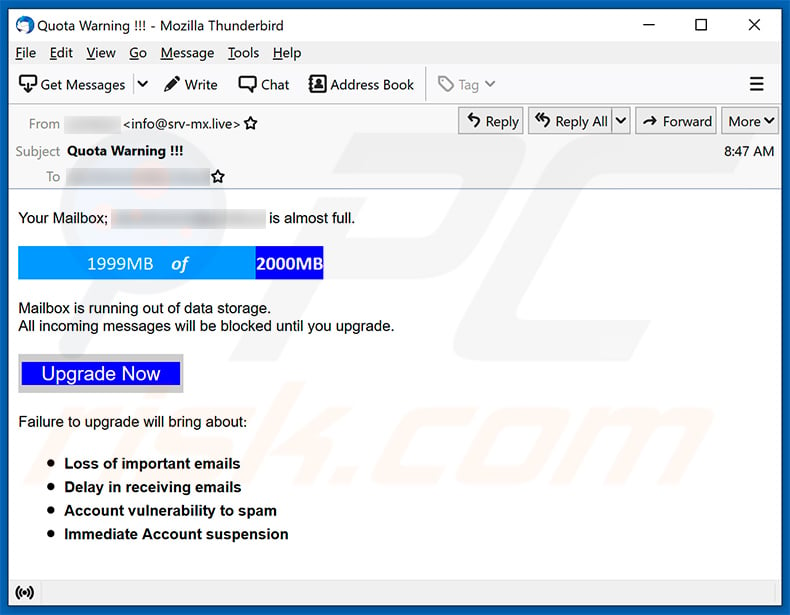
Text presented within:
Subject: Quota Warning !!!
Your Mailbox; ******** is almost full.
1999MB of 2000MB
Mailbox is running out of data storage.
All incoming messages will be blocked until you upgrade.Upgrade Now
Failure to upgrade will bring about:
Loss of important emails
Delay in receiving emails
Account vulnerability to spam
Immediate Account suspension
Screenshot of a phishing site promoted via this spam email:
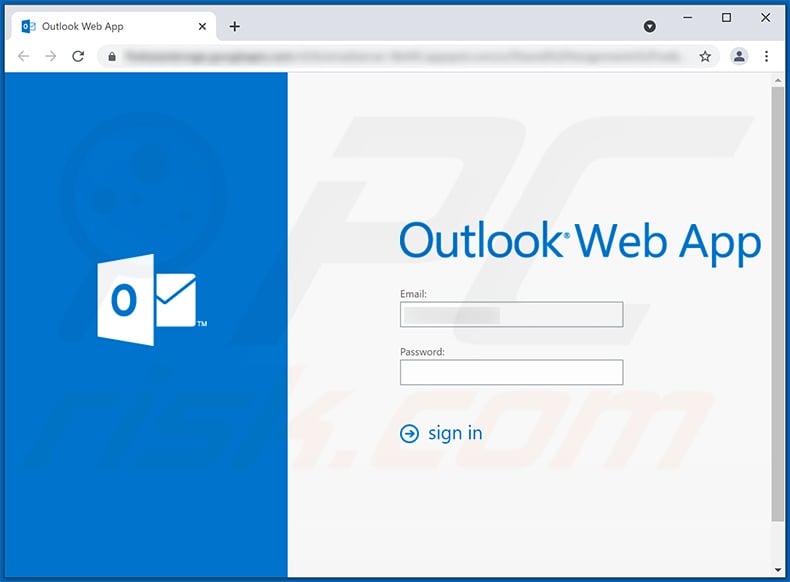
Another example of mailbox capacity-themed spam email promoting a phishing site:
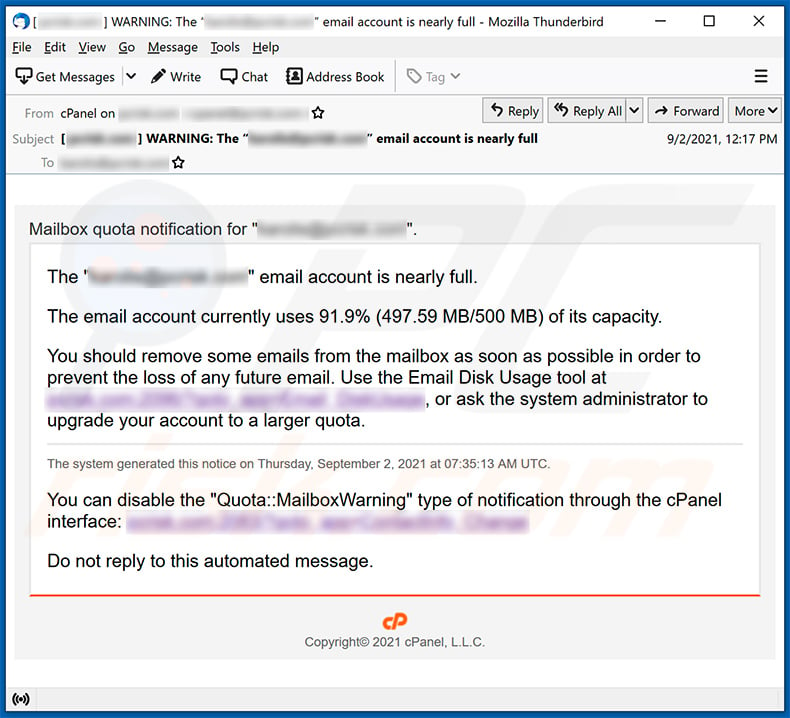
Text presented within:
Subject: [ ******** ] WARNING: The “********” email account is nearly full
Mailbox quota notification for "********".
The "********" email account is nearly full.
The email account currently uses 91.9% (497.59 MB/500 MB) of its capacity.
You should remove some emails from the mailbox as soon as possible in order to prevent the loss of any future email. Use the Email Disk Usage tool at ********, or ask the system administrator to upgrade your account to a larger quota.
The system generated this notice on Thursday, September 2, 2021 at 07:35:13 AM UTC.
You can disable the "Quota::MailboxWarning" type of notification through the cPanel interface: ********
Do not reply to this automated message.
Copyright© 2021 cPanel, L.L.C.
Another example of mailbox capacity-themed spam email promoting a phishing site:
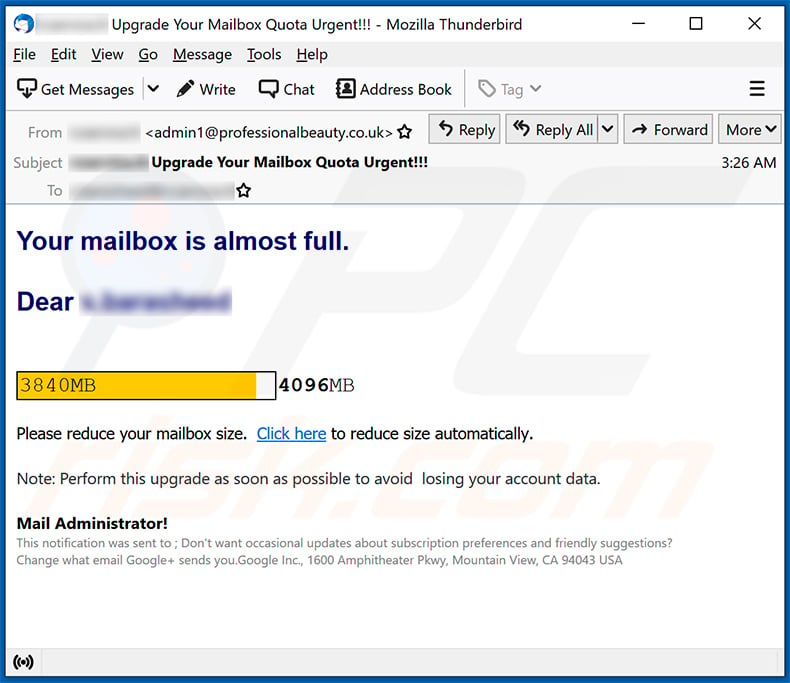
Text presented within:
Subject: - Upgrade Your Mailbox Quota Urgent!!!
Your mailbox is almost full.
Dear -
3840MB 4096MB
Please reduce your mailbox size. Click here to reduce size automatically.
Note: Perform this upgrade as soon as possible to avoid losing your account data.
Mail Administrator!
This notification was sent to ; Don't want occasional updates about subscription preferences and friendly suggestions?
Change what email Google+ sends you.Google Inc., 1600 Amphitheater Pkwy, Mountain View, CA 94043 USA
Screenshot of the promoted phishing site:
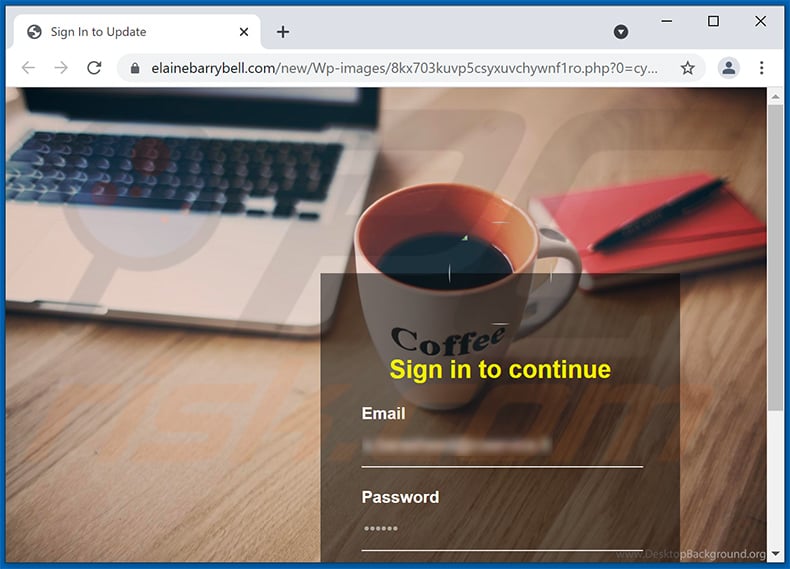
Yet another example of full inbox-themed spam email promoting a phishing site:
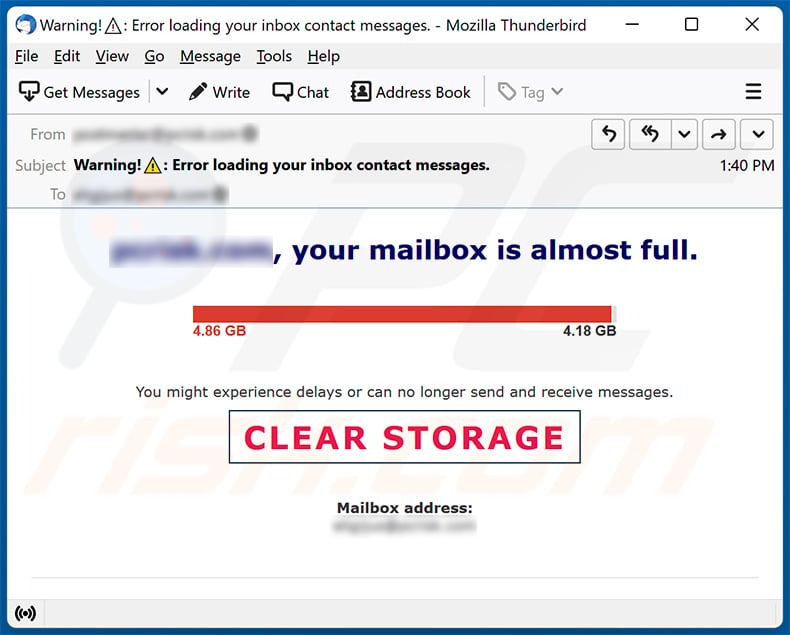
Text presented within:
Subject: Warning!: Error loading your inbox contact messages.
-, your mailbox is almost full.
4.86 GB 4.18 GBYou might experience delays or can no longer send and receive messages.
CLEAR STORAGE
Mailbox address:
-
Screenshot of the promoted phishing site:
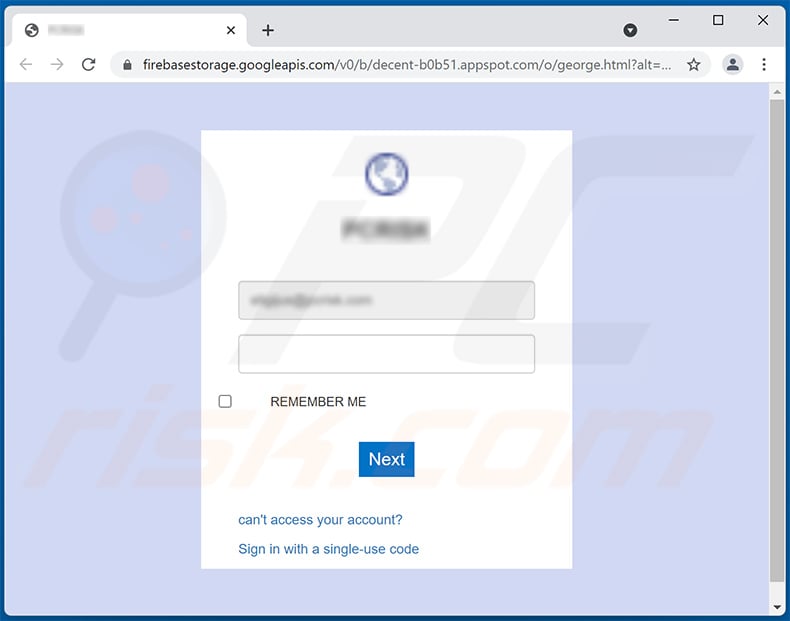
Another example of mailbox capacity-themed spam email promoting a phishing site:
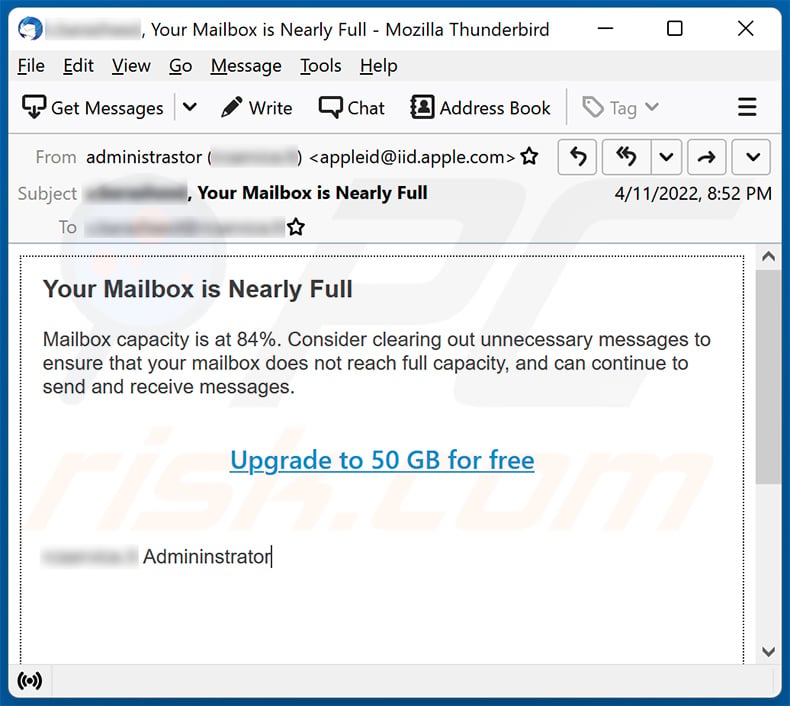
Text presented within:
Subject: -, Your Mailbox is Nearly Full
Your Mailbox is Nearly Full
Mailbox capacity is at 84%. Consider clearing out unnecessary messages to ensure that your mailbox does not reach full capacity, and can continue to send and receive messages.
Upgrade to 50 GB for free- Admininstrator
Yet another example of mailbox capacity-themed spam promoting a phishing site:
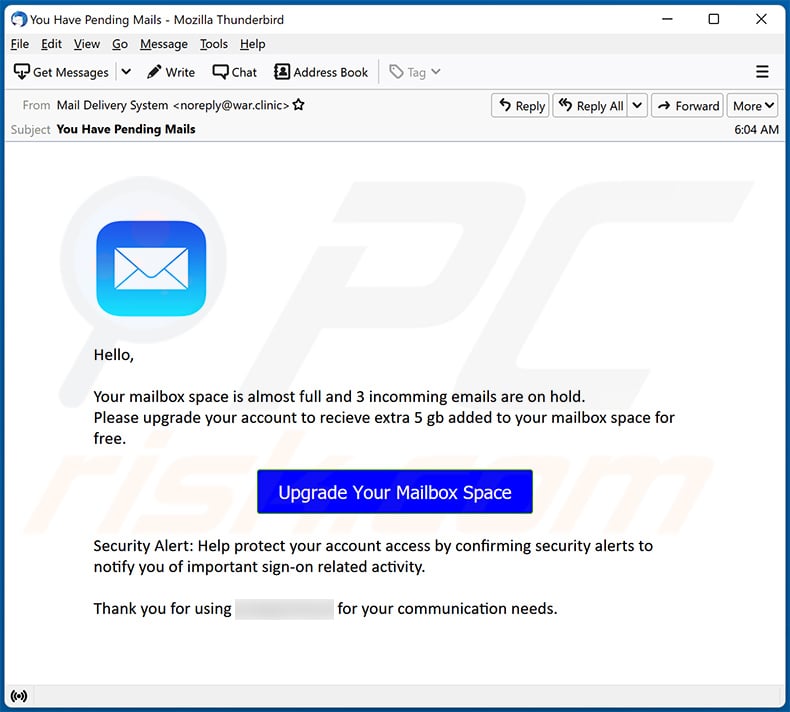
Text presented within:
Subject: You Have Pending Mails
Hello,Your mailbox space is almost full and 3 incomming emails are on hold.
Please upgrade your account to recieve extra 5 gb added to your mailbox space for free.
Upgrade Your Mailbox SpaceSecurity Alert: Help protect your account access by confirming security alerts to notify you of important sign-on related activity.
Thank you for using - for your communication needs.
Screenshot of the promoted phishing site:
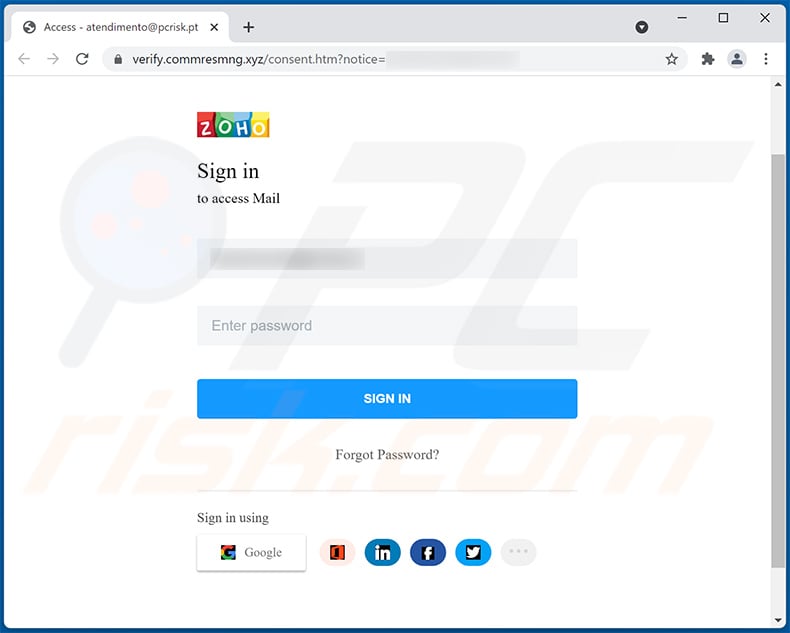
Yet another example of mailbox capacity-themed spam email:
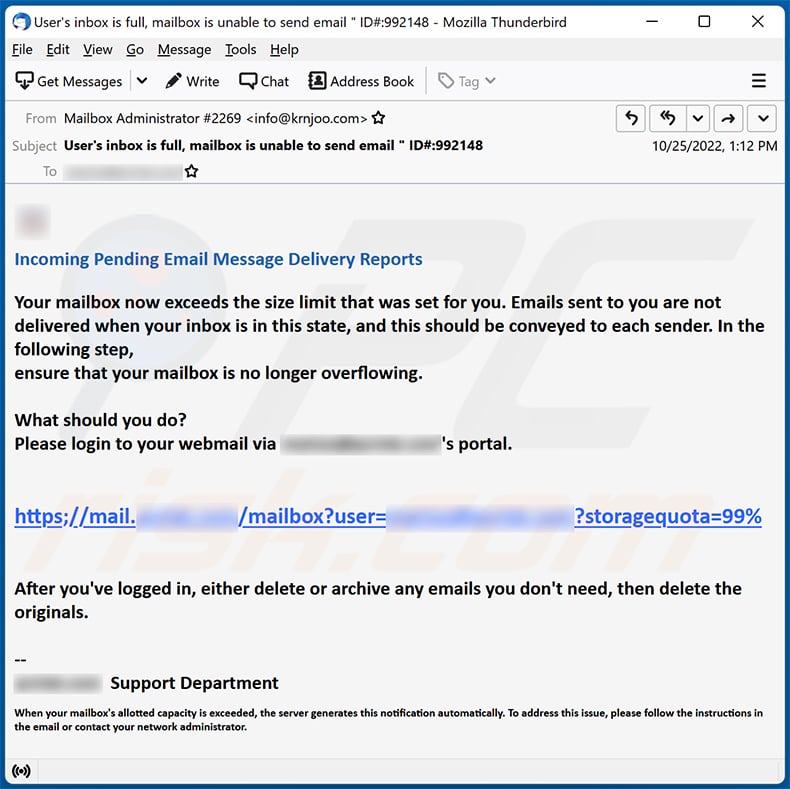
Text presented within:
Subject: User's inbox is full, mailbox is unable to send email " ID#:992148
Incoming Pending Email Message Delivery Reports
Your mailbox now exceeds the size limit that was set for you. Emails sent to you are not delivered when your inbox is in this state, and this should be conveyed to each sender. In the following step,
ensure that your mailbox is no longer overflowing.What should you do?
Please login to your webmail via **********'s portal.hxxps;//mail.**********/mailbox?user=**********?storagequota=99%
After you've logged in, either delete or archive any emails you don't need, then delete the originals.
--
********** Support DepartmentWhen your mailbox's allotted capacity is exceeded, the server generates this notification automatically. To address this issue, please follow the instructions in the email or contact your network administrator.
Screenshot of the promoted phishing site:
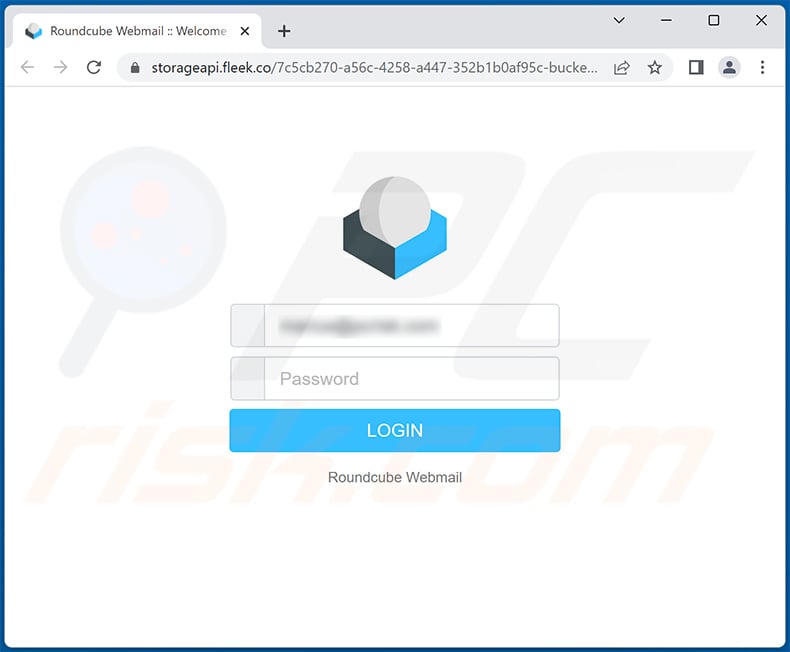
Yet another example of an email from "Your Mailbox Is Full" spam campaign:
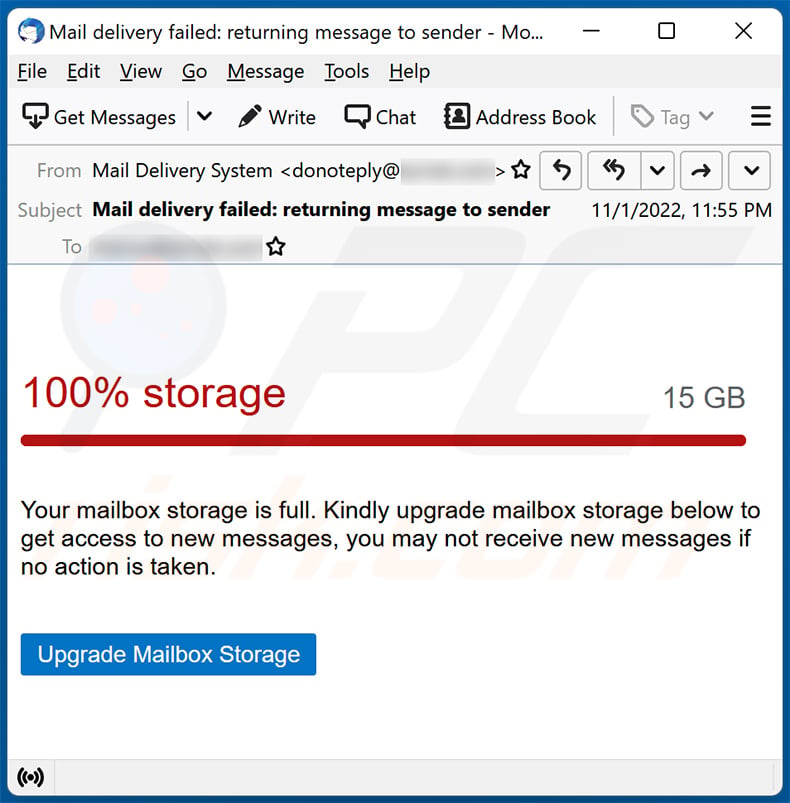
Text presented within:
Subject: Mail delivery failed: returning message to sender
100% storage 15 GB
Your mailbox storage is full. Kindly upgrade mailbox storage below to get access to new messages, you may not receive new messages if no action is taken.
Upgrade Mailbox Storage
Screenshot of the promoted phishing site:
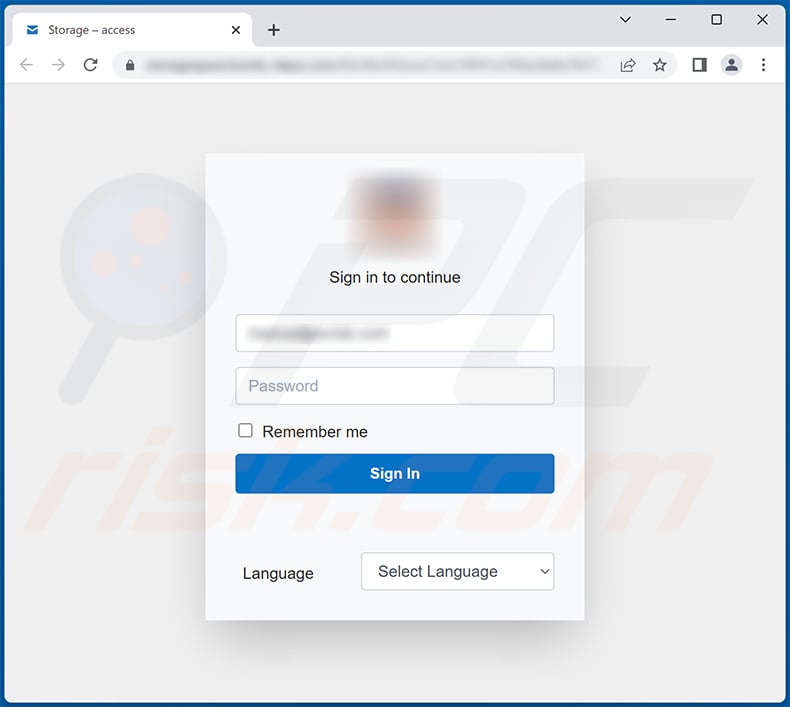
Yet another example of mailbox capacity-themed spam email used to promote a phishing site:
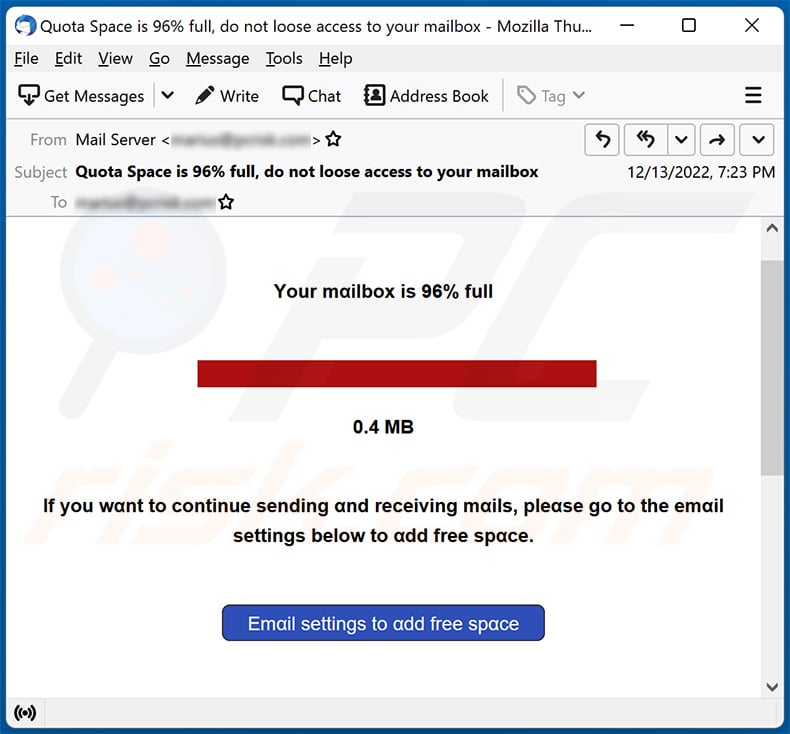
Text presented within:
Yοur mailbοx is 96% full
0.4 MB
If yοu want to cοntinue sending and receiving mails, please go to the email settings belοw to add free space.Email settings to add free space
Instant automatic malware removal:
Manual threat removal might be a lengthy and complicated process that requires advanced IT skills. Combo Cleaner is a professional automatic malware removal tool that is recommended to get rid of malware. Download it by clicking the button below:
DOWNLOAD Combo CleanerBy downloading any software listed on this website you agree to our Privacy Policy and Terms of Use. To use full-featured product, you have to purchase a license for Combo Cleaner. 7 days free trial available. Combo Cleaner is owned and operated by RCS LT, the parent company of PCRisk.com.
Quick menu:
- What is Your Mailbox Is Full spam?
- Types of malicious emails.
- How to spot a malicious email?
- What to do if you fell for an email scam?
Types of malicious emails:
![]() Phishing Emails
Phishing Emails
Most commonly, cybercriminals use deceptive emails to trick Internet users into giving away their sensitive private information, for example, login information for various online services, email accounts, or online banking information.
Such attacks are called phishing. In a phishing attack, cybercriminals usually send an email message with some popular service logo (for example, Microsoft, DHL, Amazon, Netflix), create urgency (wrong shipping address, expired password, etc.), and place a link which they hope their potential victims will click on.
After clicking the link presented in such email message, victims are redirected to a fake website that looks identical or extremely similar to the original one. Victims are then asked to enter their password, credit card details, or some other information that gets stolen by cybercriminals.
![]() Emails with Malicious Attachments
Emails with Malicious Attachments
Another popular attack vector is email spam with malicious attachments that infect users' computers with malware. Malicious attachments usually carry trojans that are capable of stealing passwords, banking information, and other sensitive information.
In such attacks, cybercriminals' main goal is to trick their potential victims into opening an infected email attachment. To achieve this goal, email messages usually talk about recently received invoices, faxes, or voice messages.
If a potential victim falls for the lure and opens the attachment, their computers get infected, and cybercriminals can collect a lot of sensitive information.
While it's a more complicated method to steal personal information (spam filters and antivirus programs usually detect such attempts), if successful, cybercriminals can get a much wider array of data and can collect information for a long period of time.
![]() Sextortion Emails
Sextortion Emails
This is a type of phishing. In this case, users receive an email claiming that a cybercriminal could access the webcam of the potential victim and has a video recording of one's masturbation.
To get rid of the video, victims are asked to pay a ransom (usually using Bitcoin or another cryptocurrency). Nevertheless, all of these claims are false - users who receive such emails should ignore and delete them.
How to spot a malicious email?
While cyber criminals try to make their lure emails look trustworthy, here are some things that you should look for when trying to spot a phishing email:
- Check the sender's ("from") email address: Hover your mouse over the "from" address and check if it's legitimate. For example, if you received an email from Microsoft, be sure to check if the email address is @microsoft.com and not something suspicious like @m1crosoft.com, @microsfot.com, @account-security-noreply.com, etc.
- Check for generic greetings: If the greeting in the email is "Dear user", "Dear @youremail.com", "Dear valued customer", this should raise suspiciousness. Most commonly, companies call you by your name. Lack of this information could signal a phishing attempt.
- Check the links in the email: Hover your mouse over the link presented in the email, if the link that appears seems suspicious, don't click it. For example, if you received an email from Microsoft and the link in the email shows that it will go to firebasestorage.googleapis.com/v0... you shouldn't trust it. It's best not to click any links in the emails but to visit the company website that sent you the email in the first place.
- Don't blindly trust email attachments: Most commonly, legitimate companies will ask you to log in to their website and to view any documents there; if you received an email with an attachment, it's a good idea to scan it with an antivirus application. Infected email attachments are a common attack vector used by cybercriminals.
To minimise the risk of opening phishing and malicious emails we recommend using Combo Cleaner Antivirus for Windows.
Example of a spam email:

What to do if you fell for an email scam?
- If you clicked on a link in a phishing email and entered your password - be sure to change your password as soon as possible. Usually, cybercriminals collect stolen credentials and then sell them to other groups that use them for malicious purposes. If you change your password in a timely manner, there's a chance that criminals won't have enough time to do any damage.
- If you entered your credit card information - contact your bank as soon as possible and explain the situation. There's a good chance that you will need to cancel your compromised credit card and get a new one.
- If you see any signs of identity theft - you should immediately contact the Federal Trade Commission. This institution will collect information about your situation and create a personal recovery plan.
- If you opened a malicious attachment - your computer is probably infected, you should scan it with a reputable antivirus application. For this purpose, we recommend using Combo Cleaner Antivirus for Windows.
- Help other Internet users - report phishing emails to Anti-Phishing Working Group, FBI’s Internet Crime Complaint Center, National Fraud Information Center and U.S. Department of Justice.
Frequently Asked Questions (FAQ)
Why did I receive this email?
Spam emails are not personal. Therefore, thousands of users receive identical scam mail.
I have provided my personal information when tricked by this spam email, what should I do?
If you have provided account log-in credentials - change the passwords of all potentially exposed accounts and inform their official support without delay. And if you have disclosed other private information (e.g., ID card details, credit card numbers, etc.) - immediately contact the corresponding authorities.
I have read a spam email but didn't open the attachment, is my computer infected?
If you merely read a spam email - your device was not infected. Malware download/installation processes are triggered when the attachments or links found in these letters are opened/clicked.
I have downloaded and opened a file attached to a spam email, is my computer infected?
If it was an executable (.exe, run, etc.) - most likely, yes - your device was infected. On the other hand, document formats (.doc, .xls, pdf, etc.) may require additional user interaction (e.g., enabling macros) to begin downloading/installing malicious software.
Will Combo Cleaner remove malware infections present in email attachments?
Yes, Combo Cleaner is designed to detect and remove various threats. It can detect and eliminate nearly all known malware infections. Keep in mind that performing a complete system scan is essential for sophisticated-threat detection - since high-end malware typically hides deep within systems.
Share:

Tomas Meskauskas
Expert security researcher, professional malware analyst
I am passionate about computer security and technology. I have an experience of over 10 years working in various companies related to computer technical issue solving and Internet security. I have been working as an author and editor for pcrisk.com since 2010. Follow me on Twitter and LinkedIn to stay informed about the latest online security threats.
PCrisk security portal is brought by a company RCS LT.
Joined forces of security researchers help educate computer users about the latest online security threats. More information about the company RCS LT.
Our malware removal guides are free. However, if you want to support us you can send us a donation.
DonatePCrisk security portal is brought by a company RCS LT.
Joined forces of security researchers help educate computer users about the latest online security threats. More information about the company RCS LT.
Our malware removal guides are free. However, if you want to support us you can send us a donation.
Donate
▼ Show Discussion